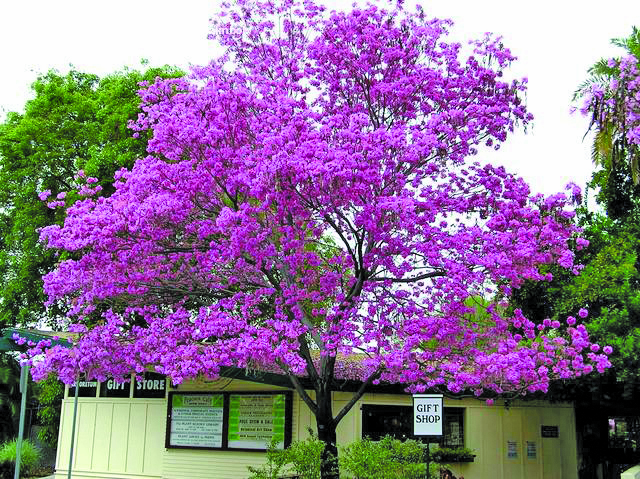By Lori Murray, Cameron County Master Gardener, Texas Superstar Specialist
If you have driven on West Harrison in Harlingen the past few weeks, you have probably noticed three small but stunning trees along the southern edge of the park dedicated to George Gutierrez between D and E Streets. They are densely covered with striking pink flowers and make quite a statement. These trees are tabebuia trees and they are in bloom a little early this year, probably due to the mostly warm winter we’ve had.
According to Grimsell’s, Frank Boggus bought a number of them several years ago for the city of Harlingen and they have been placed in numerous city parks. They also do well in private yards. Linda Matz alerted me to the early bloom and has been kind enough to share photos of hers with me.
Tabebuia is a genus of flowering plants in the family Bignoniaceae. They have been called trumpet trees, but so have other trees, so be cautious about using that term because it could lead to misidentification. The genus is mostly known for being a flowering tree and comes in a variety of colors – yellow, pink, rose-colored, and even white. It is evergreen in the warmer zones but sometimes deciduous in zones like ours. In either event, it blooms before the new leaves appear and it puts on a flamboyant show of color.
Native to the American tropics and subtropics, the tree ranges from Mexico and the Caribbean to Argentina. The name Roble de Sabana, meaning savannah oak, is widely used in Costa Rica, and it is the national tree of El Salvador. Because of its windborne seeds, it is often naturalized beyond its natural range, and there are many many varieties.
The tabebuia will grow in many types of soil but it must have good drainage, so be sure to amend clay soil. It likes full sun and is hardy in zones 10 and 11. In zone 9, it will need some protection as it can be damaged by frost but it has become a popular landscape item in Central Florida (which is zone 9), its range extended by being given proper protection.
Floridians were also cautioned that the tree tended to lay down in high winds, but I suspect they were referring to hurricane-force winds, so I don’t think it would necessarily apply here very often. Fertilize 2 or 3 times a year. Once established it will tolerate short periods of drought and is moderately salt tolerant. The tree produces long, slender seedpods late in the season and can be propagated by seeds from those pods.
This is a perfect tree for small yards and patio areas because it will not grow out of scale; it reaches a height of 20 – 30 feet with a spread of 15 up to 25 feet at maturity. It has a moderate growth rate and can even be grown in a container when small. Several sources said it would be good in parking lot islands and “buffer strips” where temperatures are high and soil space limited, but I don’t think it would be appropriate in those exposed places in our hardiness zone.
Pruning is usually not necessary, but one source suggested that planting the trees to either side of a walkway on 25 – 20 foot centers could create a canopy over the sidewalk if properly pruned. It suggested developing high, arching branches in several years by removing the lower, drooping branches for the first few years. In any event the tree will provide good shade when mature, and no pest problems were mentioned.
Most of the information I gathered was from Florida sources although aggie horticulture listed the tree as an ornamental tree for the Rio Grande Valley. The website’s archives also mentioned the tabebuia argentea as a Bignoniaceae tree with yellow flowers and cited T. pallida as “a rose-flowered species that has proven to be fairly well adapted.”
There were a large number of you tube videos on the subject also. Regardless of the source you use, there can be no doubt that one of these beauties would be a fine addition to any landscape and could likely give our old standby, the orchid tree, a run for its money.
SOURCES:
http://south -florida-plant-guide.com/tabebuia-tree.html
http://floridada.com
http://edis.ifas.ufl.edu





